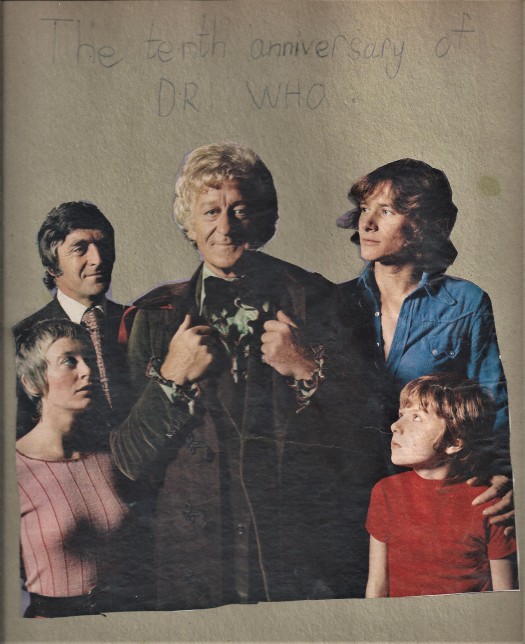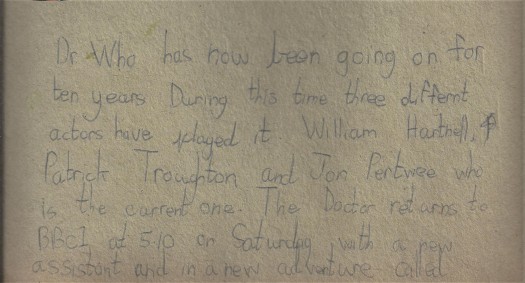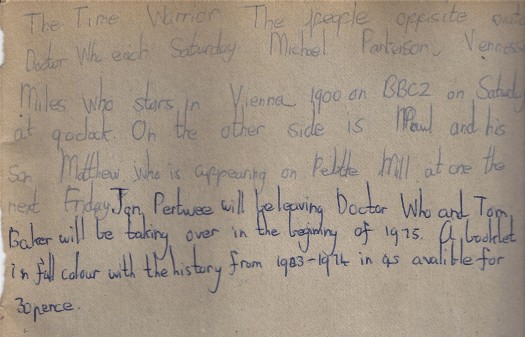Ken Dodd’s ‘We Want to Sing’, those slightly grim visits to children’s hospital wards fronted by Leslie Crowther… Christmas television wasn’t all a bundle of fun for a child of the early 70s.
But the Dr Who Omnibuses certainly were. From 1971-75, these glorified adventures became a fixture of my childhood TV Christmas as much as (well, rather more than) the Blue Peter Christmas appeal, Disney Time and All Star Record Breakers.
Part 1 gave an overview of the tradition. Here I’m recalling the stories which made up Christmas omnibuses for 1971- The Dæmons, 1972 – The Sea Devils and 1973 – The Green Death.
1971: Dr Who and the Dæmons
Tuesday 28th December, 4.20-5.50pm
1.10 Grandstand – introduced by Frank Bough
3.55 Here’s Lucy
4.20 Dr Who and the Dæmons
5.50 National News: weatherman Jack Scott
6.00 Tom and Jerry
‘For the first time a complete adventure in one programme starring Jon Pertwee as Dr Who’ – Radio Times billing.

Spotting The Dæmons in Radio Times so completely unexpectedly just before Christmas excited me tremendously. The anticipation of an hour and a half of my favourite story from my favourite TV programme totally out of the blue was a thrill almost beyond belief. There was something amazing about Dr Who brightening a mere Tuesday too.
Even better, I’d missed episode two back in the Spring as it had coincided with our Whitson (rain and mumps) break at Lyme Regis in a bungalow which needless to say had no television.
Feature length fun
Note how the Radio Times billing, (which was accompanied by a Frank Bellamy illustration depicting the Master and the Doctor) highlights the omnibus’s feature film feel, encouraging the sense that it is a post-Christmas afternoon matinee treat for all the family to gather around and enjoy.
The 4.20pm start time (earliest ever for Doctor Who to date) meant I watched it with my parents almost throughout; in 1971, Christmas  was still no more than a two day break from work for many people but this year Monday 27th and Tuesday 28th were Bank Holidays.
was still no more than a two day break from work for many people but this year Monday 27th and Tuesday 28th were Bank Holidays.
When it came to Dr Who, my father was fully signed up to The Daily Sketch’s maxim, ‘the children’s own programme which adults adore,’ dissenting only if it got ‘a bit too silly’ (Alpha Centauri was a bugbear). He enjoyed and even admired the programme when he got the chance to see it and the relaxed schedule of Christmas offered an opportunity to really sit back and soak it all up. My mother flitted in and out to prepare turkey sandwiches (well it was still the 70s) and slice Christmas cake as Azal ruminated on whether or not to sacrifice the Earth.
“A pleasing terror”
As drama dealing in the supernatural, Doctor Who relates to Christmas’ associations with darkness and magic. This is especially true of The Dæmons.
The supernatural was a popular theme in film and television in the early 70s. December 1970 had brought the unsettling Play for Today Robin Redbreast and it’s not insignificant that regular Christmas dramatisations of M.R.James ghost stories began in 1971. Derek Johnston’s Haunted Seasons: Television Ghost Stories for Christmas and Horror for Halloween is an excellent account of this broadcast tradition.
Undoctored
The Dæmons had been the indisuputable highlight of Season Eight, or at least it was certainly seen that way at the time. An expensive, location feel resembled British horror and supernatural films of the early 70s, meaning the serial lent itself extremely well to feature film format.
A reprise would remind audiences of the Master’s capture at the tale’s end, a storyline which would be followed up with the Doctor and Jo visiting an imprisoned Master in the following season’s The Sea Devils.
As a five parter, once titles and cliffhanger reprises were omitted, The Dæmons came in at just under two hours long, still a trifle longer than the average film. Perhaps it was this, or the requirements of the schedule, which dictated a trim.
Approximately thirty-five minutes are lost to give an omnibus running time of ninety minutes. So (forgetting cliffhangers and reprises) about a fifth of The Dæmons’ actual storyline has hit the cutting room floor. I don’t think it has ever been revealed who decided what should be cut but Barry Letts must have had the final say.
The omnibus drew a very respectable audience of 10.5 million viewers, more than the average of 8.3 million who viewed the original showing.
ITV were showing a number of mostly children’s programmes in opposition. As Thames viewers, we would have had The Charlie Brown Show, the always to be avoided Junior Showtime and  Magpie, none of which were competition for The Dæmons.
Magpie, none of which were competition for The Dæmons.
I still remember the sense of anticlimax when the final end credit of The Dæmons – ‘Directed by Christopher Barry’ – faded from the screen along with the ‘Dddrrrrrrrrrwwwrr!!!’
Still it was only four days to go before a brand new story began and in the meantime there was a Radio Times Frank Bellamy cover to study, depicting these strange ‘Daleks’ which, curiously, my parents were already familiar with.
1972: Dr Who and the Sea Devils
Wed 27th December, 3.05-4.45pm
1.05 Grandstand – Introduced by Frank Bough
2.35 Screen Test
3.10 Dr Who and the Sea Devils
4.35 Thursday’s Child – 1/6 adaptation
5.05 A Collection of Goodies
5.30 National News
5.40 Tom and Jerry
5.45 Fifty Years of Music – or They Don’ Write ‘Em Like That Any More
‘The complete adventure in one programme starring Jon Pertwee as Dr Who’… ‘Now you can see again the whole of the Doctor’s struggle against the Master and the strange creatures from the bottom of the sea’ – Radio Times billing.
 Thump! The Radio Times Christmas number lands on our doormat and I turn straight to the after Christmas listings and – yes! As I had hoped, The Sea Devils is there. At this point, my expectation of a tradition was established.
Thump! The Radio Times Christmas number lands on our doormat and I turn straight to the after Christmas listings and – yes! As I had hoped, The Sea Devils is there. At this point, my expectation of a tradition was established.
The billing is accompanied by a Frank Bellamy illustration and a caption bearing all the hallmarks of an enthusiastic but not very knowledgeable Radio Times staffer: ‘Time warp time – the Doc takes on the Master and the Sea Devils’.
No turkey
Again, the choice of story is fervently the right one. As Season Nine finale, The Time Monster was something of a damp squib: studio bound, experimental, too cerebral at times and a bit of a mess much of the time.
The Sea Devils was expansive, exciting, glossy, stylish, all round cracking entertainment. With its flashy seafaring escapades, the most fondly remembered story of the 1972 Season ideally lent itself to feature film format. And then there was that splendid swashbuckling swordfight between the Doctor and The Master. Could that be a turkey sandwich Jon Pertwee is munching?
8.7 million viewers watched The Sea Devils in December, compared to an average of a little over eight million for the original Spring broadcast.
Meanwhile, Thames opted for an afternoon lineup of Looks Familiar (30s/40s nostalgia panel show) at 3pm, The Saint at 3.30, and at 4.25 Lift Off With Ayshea (Roger Whittaker, Olivia Newton John, 10C.C., and Frankie Stevens).
As a six-parter, an unedited transmission of The Sea Devils would have a running time of 2:30. The omnibus clocks in at 1.40, representing a loss of approximately 50 minutes.
The Sea Devils omnibus was repeated again at 10.50am on Thursday 23rd August 1973 and again on Bank Holiday Monday 27th May 1974 in place of a cricket match making it the most exposed Pertwee story within his tenure.
Who on standby
In other repeats, Day of the Daleks appeared in a one hour slot on Monday 3rd September 1973 in place of the European Athletics Championships.
It seemed as if Dr Who was becoming a reliable schedule filler. As a child with no interest in sport, these totally ‘out of the blue’ reappearances had a magic of their own though why I was on hand to have seen them all, I cannot say. It was almost as if, even in the middle of a summer morning, by wishing Dr Who were on, I made it happen.
After that breathtaking Christmas Sea Devils omnibus there would be only three days to wait for the new season. My appetite had been whetted by the charismatic threesome adorning the New Year Radio Times cover.
1973: Dr Who: The Green Death
Thursday 27th December, 4.00-5.30pm
1.00 Racing
2.30 The World of Jimmy Young
3.15 Penguin City – narrated by Peter Scott
4.00 Dr Who: The Green Death
5.30 National News
5.40 Tom and Jerry
5.45 Top of the Pops – Ten Years of Pop Music, 1964-74 with Jimmy Saville
‘A complete adventure in one programme starring Jon Pertwee as Dr. Who. Deep in an abandoned coalmine the Doctor faces the hideous result of industrial pollution. Now you can see once more the whole story of the terrible threat of the giant maggots’ – Radio Times billing.
 1973 was the Christmas of The Goodies and the Beanstalk shown at 5.15pm on Christmas Eve on BBC-2. But even The Goodies at their best was trumped by a repeat of my favourite Dr Who story to date.
1973 was the Christmas of The Goodies and the Beanstalk shown at 5.15pm on Christmas Eve on BBC-2. But even The Goodies at their best was trumped by a repeat of my favourite Dr Who story to date.
Yes, the one with the maggots. What lovely Christmas viewing to accompany a nation collectively munching on cold turkey sandwiches.
Radio Times this time features a two panel photo-strip to accompany the billing which shows Pertwee in close-up declaring: “The maggots are all over the place!” whilst in the second panel Jo and Cliff, clambering over rocks within sight of a giant maggot, exclaim: “…come on let’s get out of here!’
BBC-1 New Season!
The 1974 season of Dr Who began not on the first Saturday of the New Year (as had been the case on 3rd January 1970, 2nd January 1971 and 1st January 1972) but two weeks before that on 15th December 1973 meaning that The Green Death omnibus fell, somewhat inconveniently, between episodes 2 and 3 of The Time Warrior.
This inauspicious timing removed some of the impetus behind a repeat as curtain-raiser to a new season, especially as Jo Grant was now a Season Ten throwback having left at the end of The Green Death.
Green Christmas
The Green Death was by far my favourite story of Season Ten and my favourite Dr Who story to date. I was thrilled that it, not, as I had feared The Three Doctors, was picked as the Christmas omnibus. The 10th anniversary story featuring William Hartnell and Patrick  Troughton was of course a major landmark and had a pantomime whimsicality which lent itself well to Christmas. But no, there’s nothing like a Welsh coal mine full of giant green maggots to brighten a Yuletide afternoon. I suspect Barry Letts would have been especially keen to push for The Green Death as the serial aired many of his environmental concerns.
Troughton was of course a major landmark and had a pantomime whimsicality which lent itself well to Christmas. But no, there’s nothing like a Welsh coal mine full of giant green maggots to brighten a Yuletide afternoon. I suspect Barry Letts would have been especially keen to push for The Green Death as the serial aired many of his environmental concerns.
For all its high revulsion factor and ecological proselytising, The Green Death also had an unusually emotional storyline: the developing romance between Jo Grant and the young Professor Jones. At the end of episode six, Jo accepts Cliff’s proposal of marriage, leaving the Doctor to drive off alone into the sunset. This affecting side to the story and its tear jerking culmination makes for an appropriately heart-warming story for Christmas.
Galloping home
I vividly recall being so excited seeing The Green Death again that I could hardly tear myself away to go to the toilet (though you’ll be pleased to know I did). I can remember galloping downstairs three steps at a time to get back to the sofa.
As a six-parter, The Green Death would have been 2.30 in episode format, so, approximately 60 minutes have been lost, unfortunately a more major incision than The Sea Devils’.
The audience was a healthy 10.4 million viewers, substantially more than the average of 7.7 million who viewed the original broadcast.
Thames gave us at 4.20pm Children of Eskdale, a re-showing of Barry Cockcroft’s acclaimed documentary and at 5.20pm Lift Off With Ayshea (Slade, New World and The All Night Rock Show sing ’20 Fantastic Sounds’).
The start of the new Dr Who season had still been marked by a Radio  Times cover (the pre-Christmas edition) which was perhaps not the best but at least Pertwee was centre stage. So it seemed as if the Radio Times tradition was confidently continuing along with the omnibuses. More than that, there was November’s brilliant Radio Times Dr Who 10th Anniversary Special to enjoy and the 1974 Dr Who Annual courtesy of Father Christmas.
Times cover (the pre-Christmas edition) which was perhaps not the best but at least Pertwee was centre stage. So it seemed as if the Radio Times tradition was confidently continuing along with the omnibuses. More than that, there was November’s brilliant Radio Times Dr Who 10th Anniversary Special to enjoy and the 1974 Dr Who Annual courtesy of Father Christmas.
Next week, I’ll conclude with a look back to the omnibuses of 1974 and 1975, Planet of the Spiders and Genesis of the Daleks, and speculate as to why the tradition ended there.
Dr Who 1970s’ Christmas Omnibuses Part 1
Dr Who 1970s’ Christmas Omnibuses Part 3

 As this is the season of good will and indulgence, I hope you’ll indulge me just a little…
As this is the season of good will and indulgence, I hope you’ll indulge me just a little… 




 era of Dr Who begins. “Tears, Sarah Jane?” I’m sure I shed some of my own as my familiar white-haired hero was transformed before my eyes into a brown curly-haired stranger for a no less traumatic second time.
era of Dr Who begins. “Tears, Sarah Jane?” I’m sure I shed some of my own as my familiar white-haired hero was transformed before my eyes into a brown curly-haired stranger for a no less traumatic second time.
 felt less than entirely satisfied.
felt less than entirely satisfied.
 themselves as obvious high calibre candidates. I struggle once we reach The Invasion of Time (1978) and The Armageddon Factor (1979) admittedly.
themselves as obvious high calibre candidates. I struggle once we reach The Invasion of Time (1978) and The Armageddon Factor (1979) admittedly.

 was still no more than a two day break from work for many people but this year Monday 27th and Tuesday 28th were Bank Holidays.
was still no more than a two day break from work for many people but this year Monday 27th and Tuesday 28th were Bank Holidays. Magpie, none of which were competition for The Dæmons.
Magpie, none of which were competition for The Dæmons. Thump! The Radio Times Christmas number lands on our doormat and I turn straight to the after Christmas listings and – yes! As I had hoped, The Sea Devils is there. At this point, my expectation of a tradition was established.
Thump! The Radio Times Christmas number lands on our doormat and I turn straight to the after Christmas listings and – yes! As I had hoped, The Sea Devils is there. At this point, my expectation of a tradition was established.

 1973 was the Christmas of The Goodies and the Beanstalk shown at 5.15pm on Christmas Eve on BBC-2. But even The Goodies at their best was trumped by a repeat of my favourite Dr Who story to date.
1973 was the Christmas of The Goodies and the Beanstalk shown at 5.15pm on Christmas Eve on BBC-2. But even The Goodies at their best was trumped by a repeat of my favourite Dr Who story to date. Troughton was of course a major landmark and had a pantomime whimsicality which lent itself well to Christmas. But no, there’s nothing like a Welsh coal mine full of giant green maggots to brighten a Yuletide afternoon. I suspect Barry Letts would have been especially keen to push for The Green Death as the serial aired many of his environmental concerns.
Troughton was of course a major landmark and had a pantomime whimsicality which lent itself well to Christmas. But no, there’s nothing like a Welsh coal mine full of giant green maggots to brighten a Yuletide afternoon. I suspect Barry Letts would have been especially keen to push for The Green Death as the serial aired many of his environmental concerns. Times cover
Times cover December 1976… on this day, or thereabouts, forty years ago I got a nasty shock.
December 1976… on this day, or thereabouts, forty years ago I got a nasty shock. opportunities to spot elements of story or setting which had passed me by the first time as well as checking those bits which didn’t reappear.
opportunities to spot elements of story or setting which had passed me by the first time as well as checking those bits which didn’t reappear. The story goes that, following original transmission in May, Episode One of The Deamons was discussed by BBC1 controller Paul Fox and Richard Levin, head of television design. Both men commended the quality of the story’s script and production and it was perhaps Paul Fox’s support which producer Barry Letts was then able to leverage to bring about the Christmas omnibus in December 1971.
The story goes that, following original transmission in May, Episode One of The Deamons was discussed by BBC1 controller Paul Fox and Richard Levin, head of television design. Both men commended the quality of the story’s script and production and it was perhaps Paul Fox’s support which producer Barry Letts was then able to leverage to bring about the Christmas omnibus in December 1971. just a few days time. Three out of five stories chosen over 1971-75 were series finales, the exceptions (quite rightly) being The Sea Devils and Genesis of the Daleks.
just a few days time. Three out of five stories chosen over 1971-75 were series finales, the exceptions (quite rightly) being The Sea Devils and Genesis of the Daleks.